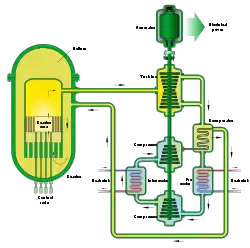المفاعلات النووية الجيل الرابع
المفاعلات النووية الجيل الرابع هي عبارة عن مجموعة من تصاميم المفاعلات النووية التي يجري بحثها حاليا للتطبيقات التجارية.[1]
نبذة
حصل تصميم المفاعلات النووية الجيل الرابع الأكثر تطوراً وهو مفاعل سريع بتبريد الصوديوم على أكبر حصة من التمويل على مر السنين من خلال تشغيل عدد من المنشئات حيث تم التصميم بتطوير دورة وقود مغلقة مستدامة للمفاعل حيث تعتبر المفاعلات السريعة بتبريد الصوديوم وهو تقنية أقل تطوراً يحتمل أن يكون له أكبر قدر من السلامة الكامنة في النماذج الستة.[2]
آلية العمل
تعمل تصميمات المفاعل ذات درجة الحرارة العالية جدا عند درجات حرارة أعلى من ذلك بكثير.[3] وهذا يسمح بتحليل كهربائي بدرجة حرارة عالية لإنتاج الهيدروجين بكفاءة وتخليق أنواع الوقود المحايدة للكربون.[4]
التصاميم
من غير المتوقع أن تكون غالبية التصميمات الستة متاحة للبناء التجاري حتى عام 2020[5] حيث تعتبر غالبية المفاعلات العاملة في جميع أنحاء العالم حاليا أنظمة مفاعلات من الجيل الثاني حيث إن الغالبية العظمى من أنظمة الجيل الأول قد تقاعدت منذ زمن وهناك عدد قليل فقط من مفاعلات الجيل الثالث قيد التشغيل من عام 2014.[6]
مفاعلات الجيل الخامس للمفاعلات وهي نظرية بحتة[7] وبالتالي لا تعتبر حتى الآن واقعية على المدى القصير مما أدى إلى محدودية التمويل من أجل البحث والتطوير.[8]
المراجع
- US DOE Nuclear Energy Research Advisory Committee (2002). "A Technology Roadmap for Generation IV Nuclear Energy Systems" (PDF). GIF-002-00. Archived from the original (PDF) on 2007-11-29.
- H. Boussier, S. Delpech, V. Ghetta et Al. : The Molten Salt Reactor (MSR) in Generation IV: Overview and Perspectives, GIF SYMPOSIUM PROCEEDINGS/2012 ANNUAL REPORT, NEA No. 7141, pp95 [1]
- "The European Sustainable Nuclear Industrial Initiative (ESNII) will support three Generation IV reactor systems: a sodium-cooled fast reactor, or SFR, called Astrid that is proposed by France; a gas-cooled fast reactor, GFR, called Allegro supported by central and eastern Europe; and a lead-cooled fast reactor, LFR, technology pilot called Myrrha that is proposed by Belgium". Archived from the original on 2013-10-09.
- "The V4G4 Centre of Excellence for performing joint research, development and innovation in the field of Generation-4 (G4) nuclear reactors have been established. 20 July 2013 National Center for Nuclear Research (NCBJ)".
- Warner, Ethan S; Heath, Garvin A (2012). "Life Cycle Greenhouse Gas Emissions of Nuclear Electricity Generation". Journal of Industrial Ecology. 16: S73–S92. doi:10.1111/j.1530-9290.2012.00472.x.
- Benjamin K. Sovacool (August 2010). "A Critical Evaluation of Nuclear Power and Renewable Electricity in Asia". Journal of Contemporary Asia. 40 (3): 381.
- Energy Department Announces New Investments in Advanced Nuclear Power Reactors…". US Department of Energy. Retrieved 16 January 2016.
- "Dual Fluid Reactor - IFK" (PDF). festkoerper-kernphysik.de. Berlin, Germany: Institut für Festkörper-Kernphysik. 2013-06-16. Retrieved 2017-08-28.
- بوابة تقانة
- بوابة طاقة
- بوابة طاقة نووية
